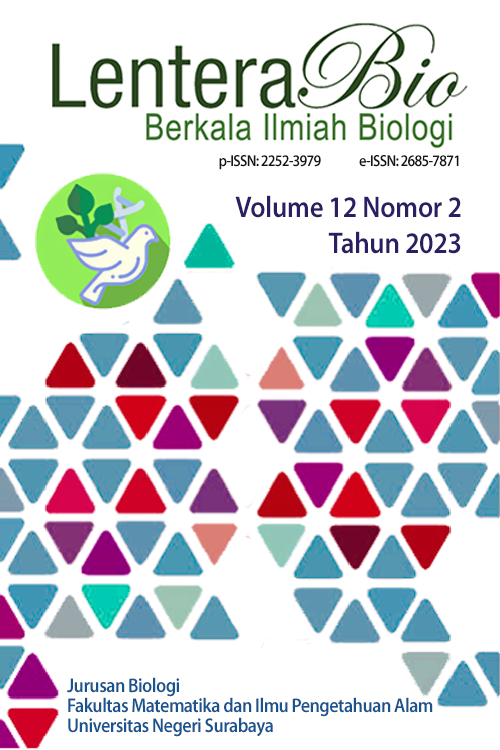Antibacterial Activity of Temu Kunci (Boesenbergia rotunda) Active Compounds to Mycobacterium tuberculosis In Silico
DOI:
https://doi.org/10.26740/lenterabio.v12n2.p132-149Keywords:
tuberculosis, resistant, Arabinosyltransferase C Enzyme, InhAAbstract
Tuberculosis is a disease that attacks the lungs and is one of the top ten causes of death in the world. In 2021 there are 283,000 cases of tuberculosis in Indonesia that have not been treated. The effectiveness of tuberculosis treatment decreases due to increased resistant of Mycobacterium tuberculosis. The utilization of herbal plants such as the rhizome of the temu kunci (Boesenbergia rotunda) can be selected as an alternative treatment to overcome the problem of resistant. The purpose of this study was to determine the drug-likeness characteristics of the active compounds of temu kunci, to determine the interaction between the active compounds of temu kunci with the target protein Arabinosyltransferase C Enzyme and InhA, and to determine the active compounds of temu kunci which have the most potential as antibacteria of M. tuberculosis in silico. The results of the drug-likeness test showed that nine selected active compounds of temu kunci complied with the Lipinski rules which were nerol, camphor, cineole, trans-methyl cinnamate, cis-p-mentha-2,8-dien-1-ol, octanal,(2,4)-dinitrophenyl) hydrazine, pinostrobin chalcone, furan-3-carboxamide,2-methyl-N-(4-morpholyl)-, dan hemanthidine. A molecular docking test showed that there were four compounds with the most potential as antibacterials with Arabinosyltransferase C Enzyme target proteins, which were octanal (2,4-dinitrophenyl) hydrazine, pinostrobin chalcone, hemanthidine, and furan 3-carboxamide 2-methyl-N-(4-morpholyl- Meanwhile, the seven most potent antibacterial compounds with InhA target proteins were pinostrobin chalcone, hemanthidine, trans-methyl cinnamate, octanal (2,4-dinitrophenyl) hydrazine, nerol, cis-p-metha-2,8-dien-1-ol, and furan-3-carboxamide2-methyl-N-(5-morpholyl)-.Further research is needed to study and clarify the specific inhibition mechanism and the toxicity of each of the active compounds of temu kunci.
Downloads
Published
How to Cite
Issue
Section
License
Copyright (c) 2023 LenteraBio : Berkala Ilmiah Biologi

This work is licensed under a Creative Commons Attribution-NonCommercial 4.0 International License.
Hak Cipta (c) LenteraBio: Berkala Ilmiah Biologi
Karya ini dilisensikan di bawah Lisensi Internasional Creative Commons Attribution-NonCommercial 4.0.
Pemberitahuan Hak Cipta.
Hak cipta dari artikel yang diterima untuk diterbitkan akan diberikan kepada jurnal sebagai penerbit jurnal. Hak cipta yang dimaksud meliputi hak untuk menerbitkan artikel dalam berbagai bentuk (termasuk cetak ulang). Jurnal mempertahankan hak penerbitan atas artikel yang diterbitkan.
 Abstract views: 1129
,
Abstract views: 1129
, PDF Downloads: 2850
PDF Downloads: 2850











